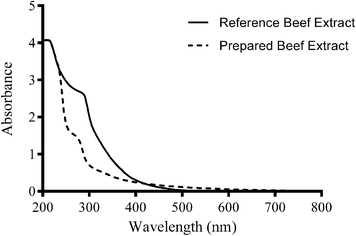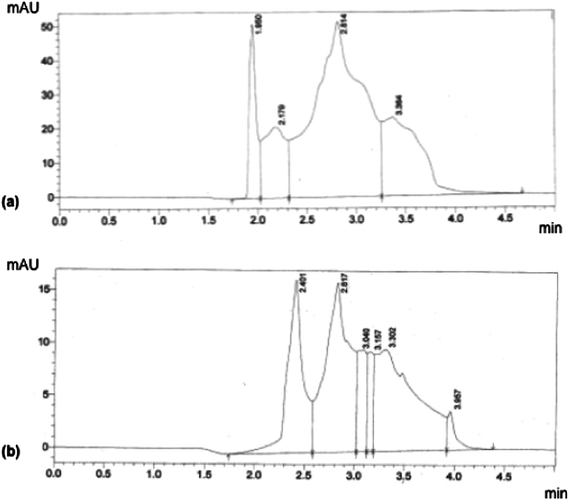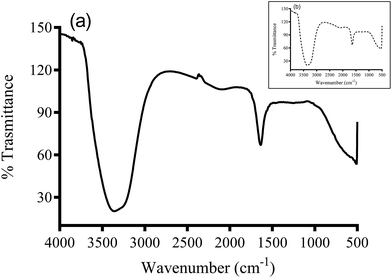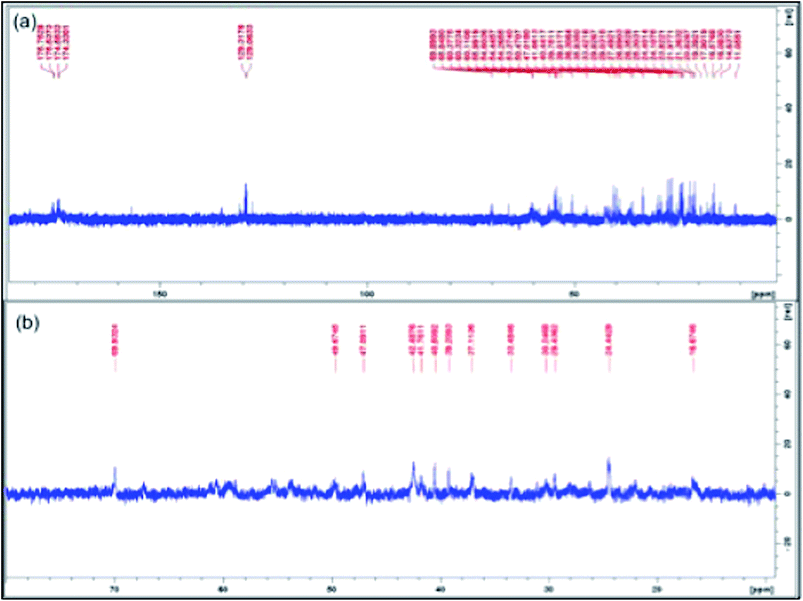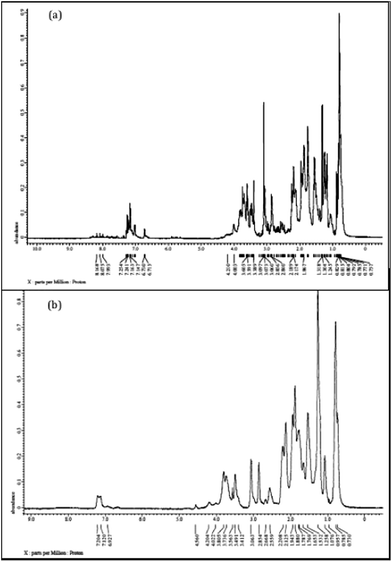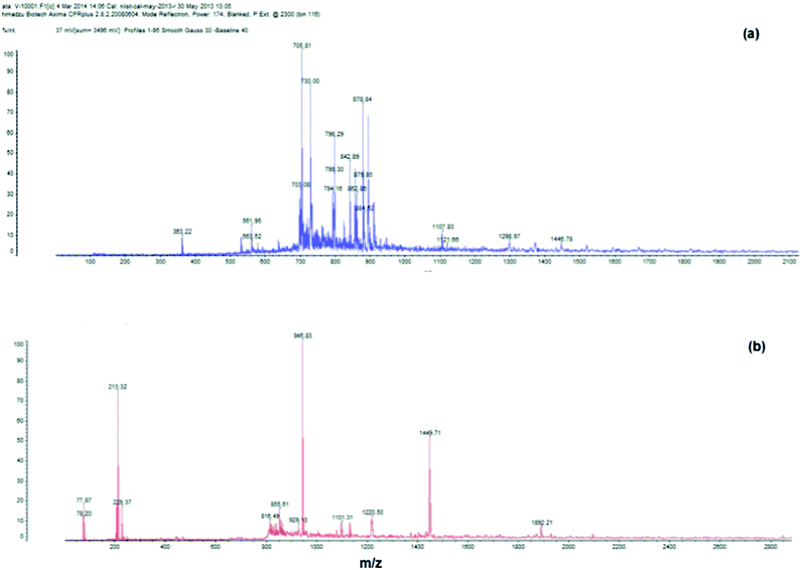Wealth from waste – beef extract for microbiological media from tannery solid waste
T. Shiny Renitha,
J. Sridevi,
M. K. Gowthaman,
N. R. Kamini,
B. Ramanaiah and
P. Saravanan*
CSIR-Central Leather Research Institute, Chennai, India. E-mail: dermagroup@yahoo.co.in; Tel: +91 44 2443 7170
First published on 6th January 2015
Abstract
Lime fleshing waste is one of the major hazardous solid wastes from leather industry. Utilization of the waste is one of the appropriate strategies to address the environmental issues and to realize economical returns. A process of preparation of beef extract from limed fleshing waste has been developed. The beef extract prepared is intended for microbial application. According to the process developed, the alkalis present in the fleshing waste were neutralized and removed by washing. Then the fleshing waste was hydrolyzed thermally and the hydrolysate obtained was lyophilized. The prepared product was characterized. The characteristics of the prepared product were compared with those of a widely accepted market product (Hi-Media). The beef extract prepared was found to be in compliance with all the requirements of the relevant standard. The product was also found to perform similarly to Hi-Media beef extract. The chemistry of the product was studied using tools such as FT-IR, HPLC, Maldi-TOF, 13C NMR and 1H NMR. The product chemistry was found to be akin to that of the beef extract of Hi-Media.
1. Introduction
The leather industry generates significant quantities of hazardous solid wastes such as fleshings, hair, trimmings, chrome shavings, buffing dust and sludge. For every ton of hide or skin processed, about 700 kg of solid wastes is generated.1 The adipose layer is the third layer from the top of the animal skin or hide. During the leather manufacturing process, the epidermis and adipose layer are removed. The mass removed from the adipose layer is called fleshings, which is one of the major solid wastes generated from leather industry. For every ton of hide about 10 Kg of fleshing waste is generated. This amounts to the generation of about 700![[thin space (1/6-em)]](https://www.rsc.org/images/entities/char_2009.gif) 000 tons of fleshing globally every year. Fleshing waste consists of about 70% water, 16% protein and 14% fat. Collagen is the protein predominantly present in adipose. Because of the presence of ample quantity of protein and moisture, fleshing waste is much susceptible to putrefaction. Putrefaction of fleshing waste is associated with significant impact on the environment.2 Fleshing waste also contains calcium oxide and sodium sulfide. Sodium sulfide is corrosive and an asphyxiating chemical. Therefore, there is a possibility of liberation of hydrogen sulfide from the waste. This waste is hence considered as hazardous and needs to be disposed securely.
000 tons of fleshing globally every year. Fleshing waste consists of about 70% water, 16% protein and 14% fat. Collagen is the protein predominantly present in adipose. Because of the presence of ample quantity of protein and moisture, fleshing waste is much susceptible to putrefaction. Putrefaction of fleshing waste is associated with significant impact on the environment.2 Fleshing waste also contains calcium oxide and sodium sulfide. Sodium sulfide is corrosive and an asphyxiating chemical. Therefore, there is a possibility of liberation of hydrogen sulfide from the waste. This waste is hence considered as hazardous and needs to be disposed securely.
Preparation of many value added products from various solid wastes have been reported. Preparation or extraction of collagen, gelatin and collagen hydrolysate from bovine-limed split wastes was reported.3 Fleshing waste was used for the production of fertilizers.4 Fleshing waste was processed to generate methane.5 Hydrolysate prepared form the process of fermentation of fleshing waste using Enteroccus faecium was found to contain high levels of anti-oxidant compounds.6 Lipids from fleshing waste was extracted and used for producing biodiesel.7 Collagen containing tannery wastes could be valorized to tailor-made collagen biopolymers of different shapes such as fibers, gels, films and sponges.8 Olein was produced from hide pre-fleshing following the processes of extraction and subsequent fractionation of the fatty matter.9
Beef extract is dehydrated extract of bovine tissues. Generally various organs and tissues of bovine source are used for the preparation of beef extract. Microbiological grade beef extract is one of the important and widely used constituents of microbiological culture media. Edible grade beef extract is widely used in soups, gravy, sauce, broths, flavors and other prepared foods. The global demand of beef extract is huge and growing constantly.
This paper presents the process of preparation of beef extract from limed fleshing waste. The details of characterization of the product in comparison with widely accepted market product (Hi-Media beef extract) are also presented. The efficiency of the beef extract produced and its chemistry are also studied and presented in this paper.
2. Methodology
2.1. Source of fleshings
Limed fleshings were obtained from M/s S A Abdul Azeez & Co., Erode, India, a leather manufacturing company. This tanning unit has been manufacturing chrome tanned leather from wet-salted Indian cow hides.2.2. Chemicals
All the chemicals used for analysis were of analytical grade. Beef extract powder was procured from Hi-Media Chemicals, India and used as the reference product.2.3. Preparation of beef extract from fleshings
As stated earlier the limed fleshing waste is obtained after liming processes followed by the mechanical operation of fleshing. Lime (CaO) and sodium sulfide (Na2S) are used for liming process. Fleshing therefore contains lime and sodium sulfide.Limed fleshing waste was washed four times with 200% v/w of water and once with 3% v/w of acetic acid to remove alkalis such as calcium oxide and sodium sulfide. The conventional process vessel of drum used in leather manufacturing was used for process of alkali removal. The fleshing waste free from alkali was then hydrolyzed hydrothermally at 121 °C and 15 psi for 30 min in an autoclave. The protein hydrolysate (PH) obtained was in liquid state. The resultant product of hydrolysate was allowed to cool and lipid was removed by centrifugation at 3000 rpm for 15 min. The PH free from lipids was lyophilized. The flowchart of the process is given as Fig. 1.
2.4. Characterization
The prepared beef extract (PBE) was characterized and compared with the characteristics of reference beef extract (RBE) obtained from M/s Hi-Media. The CaO content of the fleshing waste was analyzed following iodine method. According to this method, the sample was cut into small pieces and added with boiling water. It was shaken for 10 min and 5 ml of 0.1 N iodine solution was added under occasional stirring. The solution made up with water and added with freshly prepared starch indicator was titrated against 0.1 N sodium thiosulfate. The physical parameters such as appearance and clarity were assessed using Jasco UV-visible Spectrophotometer (Model V-660). Turbidity was estimated using spectrophotometer.10Elemental analysis (CHNS) of PBE and RBE was carried out using elemental analyzer (Vario cube of Elementar). For CHNS analysis, samples were weighed (3–5 mg), enveloped in tin capsule and combusted in the reactor at 1150 °C.
The moisture content was determined by measuring the mass of the sample before and after the removal of moisture by drying in hot air oven followed by desiccation till attaining constant weight. The ash content was determined following the standard methods.11
Indole test was carried out by inoculating 18–24 h culture to the beef extract media and incubated for 24 h. A few drops of Kovacs reagent was added and colour developed was observed.12
Both PBE and RBE were analyzed using HPLC (SPD-M20A LC-20AD PDA UFLC Shimadzu). Amino acid separation was done by a C18 CDS column-Merck and the detection was done at 254 nm.
2.5. Growth promotion test
Growth promotion test was conducted by inoculating 1 ml of 24 h culture of microbes into media and the growth was studied. Media was prepared using PBE and RBE. Bacterial strains such as Escherichia coli (MTCC 443), Staphylococcus aureus (MTCC 3160), Pseudomonas aeruginosa (MTCC 1934) were used in this study for assessing the growth promotion efficacy.2.6. Spectral analysis
FT-IR spectra of PBE and RBE were obtained using JASCO FT/IR-4200 Spectrometer.13C NMR and 1H NMR studies in solution were carried out for PBE and RBE. For 13C NMR analysis, the samples (20 mg) were dissolved in D2O. NMR analysis was carried out using in 400 MHz Bruker NB Avance III NMR spectrometer (13C frequency = 100 MHz). 13C NMR spectrum was recorded using Zgpg30 pulse sequence with 1024 scans. 1H NMR sample was prepared in D2O followed by pre-saturation of the solvent peak. Processing and plotting was done using TopSpinNMR software.
Maldi-TOF of the samples was also done. Sample was dissolved in acetonitrile. The matrix (α-cyano-4-hydroxycinnamic acid) was co-crystallized with the sample. Ions were separated by the mass analyzer based on the time of flight. Maldi-TOF was carried out using Shimadzu Biotech AXIMA-CFR-plus.
3. Results and discussion
3.1. Process of preparation of beef extract
Four batches of PBE preparation were carried out to ascertain the repeatability of the process. The process repeatability is verified statistically by estimating the process control parameters and processing them statistically. Lime should not be present in the final product and the pH should be between 5.9 and 6.9. Therefore it is essential to remove the lime from the fleshing wastes. Therefore the CaO content had been taken as one of the process control parameters. The final product is collagen hydrolysate, the active content of which can be assessed through estimation of total nitrogen. Therefore total nitrogen had been taken as another process parameter. The lime is present in two forms in the fleshing wastes namely the free lime, which is present in the water of the fleshing wastes and the combined lime, which is combined with the amino acids of the protein. In the first step, the fleshing waste was washed to remove free lime. From the results (Table 1), it is clear that the CaO content of the fleshing waste was partly removed. The CaO content of the fleshing waste was 3.8% and 2.7% after washing. Then the fleshing waste was treated using 3% of acetic acid in 200% water to remove the combined lime as given below.| Ca(OH)2 + CH3COOH → CH3COOCa + 2H2O |
| Stage | Weightb (kg) | CaOa (% w/w) | Total nitrogena (% w/w) |
|---|---|---|---|
| a On moisture free basis (mean values of four batches with deviation).b Average of four batches of process BDL: Below Detectable Level. | |||
| Fleshings | 1.30 | 3.8 ± 0.6σ | 6.4 ± 0.4σ |
| Fleshings after washings | 1.20 | 2.7 ± 0.3σ | 6.0 ± 0.8σ |
| Fleshings after acetic acid treatment | 1.10 | 0.1 ± 0.7σ | 5.5 ± 0.5σ |
| Product mass after thermal hydrolysis | 0.75 | BDL | 4.9 ± 0.6σ |
| PBE after lyophilization | 0.19 | BDL | 13.2 ± 0.4σ |
Acetic acid neutralizes the lime to produce calcium acetate and water. Solubility of calcium acetate is significantly high and the salt formed was removed effectively by subsequent washing. Due to the removal of alkali, the CaO content was reduced to 0.1%. And also the alkalinity was neutralized. Total nitrogen content of the fleshing waste after alkali removal was found to be 5.5%. There is no much change in the total nitrogen level as there is a little change in the total mass of the fleshing waste. After thermal hydrolysis, the mass containing protein hydrolysate and lipid fraction was collected. Alkali content in the mass after thermal hydrolysis was found to be below detection limit. The total nitrogen after thermal hydrolysis was found to be 4.9%. Finally the protein hydrolysate was separated and lyophilized. CaO content of the lyophilized powder was below detection limit and the total nitrogen was 13.2%. The increase in total nitrogen is due to proportionate loss of water, as the total nitrogen is expressed on moisture free basis. The values of CaO and total nitrogen were processed statistically and it was found that the ranges were below 1σ. The range of observed data when expressed as multiples of standard deviation (1σ), lower the multiple of σ better is the capability or repeatability of the process. All the mean values of CaO and total nitrogen were lesser than 0.8σ. This indicates that the process is highly repeatable. The average yield was found to be 14.62%.
3.2. Physical parameters
The appearance, solubility and clarity are important physical parameters of beef extract for microbiological media. These three parameters were assessed subjectively. The lyophilized powder of PBE was found to be yellowish to brownish yellow in colour similar to RBE. Aqueous solution (1% w/v) of PBE was found to be clear akin to that of RBE. The clarity of 1% solution PBE and RBE was assessed spectrophotometrically. The UV-visible spectra of PBE and RBE were obtained and found to be similar in visible region (Fig. 2). Turbidity was measured using spectrophotometer at 750 nm. Turbidity of RBE was found to be 16.86 NTU and that of PBE was found to be 16.934 NTU. The UV-visible spectra in visible region and turbidity values indicate that the colour and turbidity of PBE is similar to that of RBE. The solubility of PBE in water was found to be 22 g l−1 and that of RBE was 20 g l−1 at 25 °C. The results clearly indicate that the physical characteristics of PBE were congruent to that of RBE.3.3. Chemical characteristics
The chemical characteristics of PBE such as total nitrogen, chloride, loss on drying, pH, indole test and residue on ignition were estimated (Table 2) and compared with that of RBE. Nitrogen level is one of the important parameters of beef extract. The nitrogen level should be 11% or more as per the standard for ensuring adequate growth of microorganisms. The chloride content of PBE was found to be 0.545%, which is much lower than the upper limit. In the process of preparation of PBE the formation of chloride is seldom possible. Therefore the level of chloride was found to be much lower than the upper limit of the requirement. Loss on drying is another important parameter. This is indirect measure of the moisture content. If the loss on drying of beef extract is more than 6%, which is the upper limit then it might be detrimental to the growth of organisms. The loss on drying of the PBE was found to be 2.3%, which is much lower than the upper limit. The pH of the beef extract shall be between 5.9 and 6.9 and the pH of the PBE was found to be 6.8, which is within closer to the upper limit. Tryptophan must be present in the RBE and the same for PBE was ensured following the indole test.12 On ignition, beef extract forms residue. The residue is mainly the inorganic components especially metal oxides. The metal oxides should not be more than 12%. Level of metal oxide more than 12% may hamper the growth of microorganisms. The residue on ignition of the PBE was found to be 10%, which is lesser than the upper limit. The residue on ignition might have been contributed by the salts primarily calcium acetate formed during alkali removal process of preparation of PBE.3.4. Growth test
The suitability of the PBE for growing microorganisms was assessed by growing test species in media containing PBE in comparison with that of RBE. Microbial load was estimated for both RBE and PBE (Fig. 3). Results indicate that the test microorganisms multiply almost in a similar level and rate in PBE containing media to that of RBE. The results are evident that the PBE could bring about growth of microorganisms much similar to RBE.3.5. Amino acid analysis
The chromatogram of HPLC indicated the presence of constituent amino acids (Fig. 4). The RBE was found to contain alanine, arginine, aspartic acid, cystine, l-tyrosine, isoleucine, leucine, threonine, tryptophan, valine, methionine and phenyl alanine. The chromatogram of PBE indicates the presence of l-tyrosine, cysteine, isoleucine, leucine, threonine, tryptophan, valine, methionine and phenyl alanine. The amino acid composition of PBE is not same as that of RBE but similar. Microorganisms break down the amino acids present in the beef extract and utilize them as their source of carbon and energy. Composition of different amino acids in the media components is essential for the growth of various microorganisms. Therefore to assure the growth of different microorganism, the beef extract should contain wide range of amino acids. The minor deviations in amino acid composition between PBE and RBE do not appear to have any significant effect on the performance of the PBE, which was evident from the growth test (Fig. 3).3.6. Spectral study
1H-NMR pattern and fingerprints can be used to identify the samples for the presence of adulterants and contaminants. 1H-NMR spectra show a large number of resonance peak signals with a high degree of overlap. The samples were analyzed and compared with 1H-NMR spectral data (Fig. 7). Much work had not been done on NMR of beef extract.14 In some cases, due to the strong overlap of the multiple resonances, it is difficult to assign any particular organic moiety. However it is clear that both PBE and RBE displayed high degree of overlapping signals contributing to degeneracy of spectral quality.
3.7. Elemental analysis
The results of elemental analysis are presented as Table 3. The carbon percentage of PBE was found 37.18% against 42.32% for the RBE. The percentage of H and N were found to be 5.55% and 13.44% respectively for PBE. Percentage of H and N of RBE were found to be 6.21% and 14.41% respectively. Sulfur (S) content of PBE was found to be 0.26%, which is equal to the level of S in RBE. The elemental composition of PBE and RBE indicates that there is a deviation in the amount of C, H and N. However the deviations are not significant.| Name of the element | Amount (%) | |
|---|---|---|
| RBE (Hi-Media) | PBE | |
| Carbon | 42.32 | 37.13 |
| Hydrogen | 6.21 | 5.55 |
| Nitrogen | 14.41 | 13.44 |
| Sulphur | 0.26 | 0.26 |
4. Conclusion
From the results, it is evident that the physical characteristics, performance, amino acid composition, spectral characteristics and elemental composition of the PBE were either compliant to the requisite standards or congruent with that of RBE. Therefore, it can be concluded that the process of preparation of beef extract from fleshing waste is appropriate to prepare beef extract for microbial media. Hence, this could be a possible solution to the issue of disposal of fleshing waste. Moreover the process is associated with the scope of production of a value added product (beef extract) from the hazardous waste (fleshing waste). As the price of the beef extract is about US% 100 per kg, this paper provides a technological solution to the problem of disposal of hazardous waste compounded with attractive economical returns.Acknowledgements
This work was carried out as part of the project ‘Zero Emission Research Initiative for Solid wastes’ (ZERIS) (CSC 0103), a cross cluster project of Council for Scientific and Industrial Research and the project is lead by CSIR-CLRI, India.References
- R. Chakraborty and S. K. Sarkar, J. Soc. Leather Technol. Chem., 1998, 82, 56–58 CAS.
- J. Kanagaraj, K. C. Velappan, N. K. C. Babu and S. Sadulla, J. Sci. Ind. Res., 2006, 65, 541–548 CAS.
- H. Ozgunay, S. Colak, M. M. Mutlu and F. Akyuz, Pol. J. Environ. Stud., 2007, 16, 867–873 CAS.
- Z. K. Zhang, G. Y. Li and B. Shi, J. Soc. Leather Technol. Chem., 2006, 90, 23–28 Search PubMed.
- N. Vasudevan and A. D. Ravindran, Curr. Sci., 2007, 93, 1492–1494 CAS.
- A. K. Rai, T. General, N. Bhaskar, P. V. Suresh, P. Z. Sakhare, P. M. Halami, L. R. Gowda and N. S. Mahendrakar, Bioresour. Technol., 2010, 101, 1885–1891 CrossRef CAS PubMed.
- E. Alptekin, M. Canakci and H. Sanli, Fuel, 2012, 95, 214–220 CrossRef CAS PubMed.
- M. Catalina, J. Cot, A. Mariana Balu, J. Carlos Serrano-Ruiz and R. Luque, Green Chem., 2012, 14, 308–312 RSC.
- G. P. S. Priebe and M. Gutterres, Lat. Am. Appl. Res., 2012, 42, 71–76 Search PubMed.
- L. G. Kevin, Estimating turbidity (NTU) from absorption data. Sensus Technical Note (SEN-TN-0010), 2009 Search PubMed.
- APHA, Standard Methods, American Public Health Association, Washington, DC, USA, 2005 Search PubMed.
- J. F. MacFaddin, Biochemical tests for identification of medical bacteria, Lippincott Williams & Wilkins, Philadelphia, PA, 3rd edn, 2001 Search PubMed.
- D. S. Wishart, C. G. Bigam, A. Holm, R. S. Hodges and B. D. Sykes, J. Biomol. NMR, 1995, 5, 67–81 CrossRef CAS.
- M. A. Brescia, A. C. Jambrenghi, V. di Martino, D. Sacco, F. Giannico, G. Vonghia and A. Sacco, Ital. J. Anim. Sci., 2002, 1, 151–158 Search PubMed.
| This journal is © The Royal Society of Chemistry 2015 |


